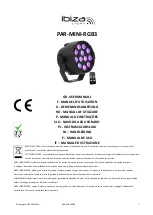
Preparing for use
R&S
®
RTP
21
Getting Started 1337.9946.02 ─ 07
►
NOTICE!
Risk of electrostatic discharge. Electrostatic discharge can damage
the electronic components of the product and the device under test (DUT).
Ground yourself to prevent electrostatic discharge damage:
a) Use a wrist strap and cord to connect yourself to ground.
b) Use a conductive floor mat and heel strap combination.
During operation, if the firmware observes a serious unexpected disturbance (e.g.
due to ESD), it resets some hardware components and initiates a new alignment
to ensure proper instrument functioning. Then it restores the user settings to the
state before the disturbance.
4.6
Connecting to power
For safety information, see
"Connecting to power and grounding"
The R&S
RTP can be used with different AC power voltages and adapts itself
automatically to it.
The instrument has a C20 connector. A list of appropriate power cables is given in
the user manual. Refer to the data sheet for the requirements of voltage and fre-
quency.
The nominal ranges are:
●
100 V to 240 V AC at 50 Hz to 60 Hz, and 100 V to 130 V at 400 Hz, with
maximal 10% voltage fluctuation on line
●
max. 13 A to 4.7 A
1. Plug the AC power cable into the AC power connector on the rear panel of the
product. Only use the AC power cable delivered with the product.
2. Plug the AC power cable into a power outlet with ground contact.
The required ratings are listed next to the AC power connector and in the data
sheet.
Connecting to power
















































